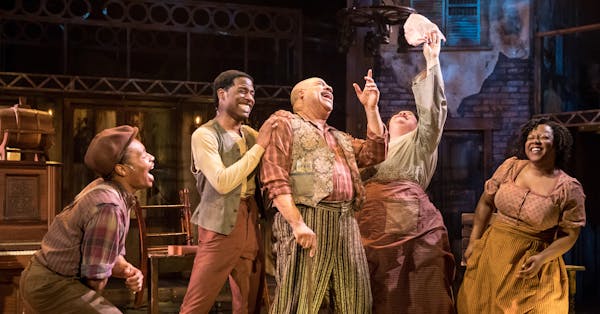It's not happening in the theater meccas of New York, London or Chicago.
"Five Points," a much-anticipated new musical about the cultural tensions between African- and Irish-Americans that gave rise to tap dance, will premiere Saturday at the cozy Ritz Theater in Minneapolis.
It could be an electrifying debut for the composing team of Douglas Lyons and Ethan Pakchar, who have Broadway ambitions for the show.
Based in New York, they met in 2012 in the touring company of "The Book of Mormon" (Lyons was onstage, Pakchar in the pit on guitar). They've been called the next Pasek and Paul, the duo behind the Oscar-winning "La La Land" and current Broadway smash "Dear Evan Hansen."
The stakes also are high for Twin Cities playwright Harrison David Rivers, whom they hired to write the book, and Theater Latté Da, which is producing the show with an all-local cast.
"Five Points" represents a bold statement as the theater marks its 20th year.
"We've certainly done big musicals before but this is hugely ambitious, in terms of the size of the cast, the scope of the story, and [the fact] that both music and dance are equal elements," said Latté Da artistic director Peter Rothstein, who has overseen the show's accelerated development over the past two years.
"This takes us to the next level."
Super-sized dance-offs
Named for the seedy district of Manhattan that served as a gateway to poor immigrants and a refuge for ex-slaves, "Five Points" is set in 1863 as the Civil War raged.
Blacks and whites lived and worked together, often uneasily, in this community of strivers. They also competed in dance-offs — freestyling much like battling rappers do today. These contests grew into spectacles that drew huge crowds and were promoted by showmen such as P.T. Barnum, a character in the show.
"The way they danced then was like a sporting event," said Lyons, who wrote the lyrics and collaborated with Pakchar on the music. "It was their Super Bowl."
The narrative is built around two hoofers who competed in real life. William Henry Lane, aka Master Juba, was an inventive African-American master. John Diamond was an Irish minstrel who fused black steps with those from his homeland.
Lane is portrayed by Lamar Jefferson, part of the cast that premiered the musical "Girl Shakes Loose" at Penumbra last spring, while Ben Bakken, seen recently in Chanhassen's "Grease," plays Diamond.
The creative team has exercised its artistic license to give body and soul to people about whom not much is known. The contests between Lane and Diamond took place in the 1840s, but dropping them "in the middle of the Civil War gives us a ticking time clock," Lyons said.
And although "Five Points" is history-based, it's aimed at modern audiences. The music is "something that you could hear on the radio," said Lyons.
Rivers said the added dramatic underpinning helped flesh out characters who are mere historical sketches.
"Willie was a very young man who essentially died of exhaustion after being danced to death by P.T. Barnum," the playwright said. "And John Diamond was a good match for him. In these dance battles, one of the men would star and the other would mimic what he did and take it further. They would go back and forth like that, and their distinct styles would congeal into what we know as tap."
He sees the show as a metaphor for America.
"These two cultures are thrust together and the result of their different styles is something brand new."
Parallels to 'Ragtime'
That's also a central idea of "Ragtime," the musical to which this show is inevitably compared.
After a memorable Minneapolis staging of "Ragtime" in 2016, Rothstein did a version in Seattle last year, starring Lyons.
"This is set 40 years before 'Ragtime,' but there are thematic similarities certainly, around issues of national identity and cultural clashes that led to the birth of new art forms," the director said.
While there are three principal narratives in "Ragtime" — around Jewish immigrants, African-Americans and WASPs — "Five Points" has only two. Even so, it is jam-packed, even epic in scale. "Each story line can easily be its own musical, and we've doubled them up," said Latté Da's new associate artistic director, Elissa Adams.
The show has a high-gloss cast of 14 Twin Cities dancers, singers and actors — including Ann Michels, Dieter Bierbrauer, Thomasina Petrus and T. Mychael Rambo, fresh from playing The Wiz at Children's Theatre — plus a five-piece band led by Latté Da's musical director, Denise Prosek. Kelli Foster Warder, who choreographed "Ragtime," is creating the tense, sometimes exultant dances.
The creative team chose not to replicate some egregious practices of the past, including blackface, which both Lane and Diamond used. It was mindful, too, of the "whitewashing" criticism around the recent Barnum film "The Greatest Showman."
"We wanted to illuminate how he exploited marginalized talent," said Rothstein. "We're still finessing that." The story line creates parallels between the way Barnum pitted groups against each other for money, and how the military created conflict by drafting Irish immigrants while refusing blacks.
These lessons aren't just historical, said Rothstein, referencing structural inequities that cause the poor and underserved to turn on each other.
"This is a story about us, today."
612-673-4390 • @rohanpreston

An infamous heist put this North Woods town in the global spotlight. Nervous breakdowns and Hollywood deals ensued.

Caitlin Clark helps KARE 11 and Fox 9 reporters bond with their daughters

Fewer loon chicks surviving due to climate change, researchers say

